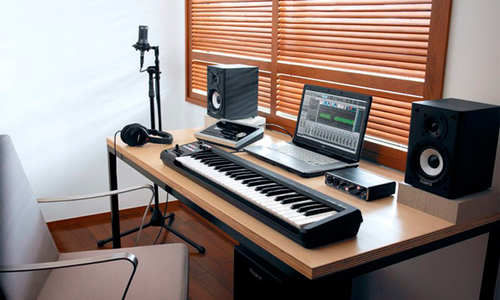
Sooner or later, everyone who wants to transfer their piece of music to a computer and edit it there will come across the term sound card. This portable hardware device is also known as an audio interface. The card itself provides the conversion of an analog signal into a digital form that a computer can easily work with. The device also works in the opposite direction, converting digital audio from a computer into an analog format.
Each computer has a built-in sound card, but with it, high-quality signal conversion from analog to digital is impossible. The built-in sound card in a computer is sufficient for playing compressed audio, but it is not suitable for high-quality recording. How to choose a good sound card?
One of the important criteria is the number of inputs: it must correspond to the number of recorded instruments. Particular attention should be paid to recording electric guitar, keyboards or bass guitar. For these instruments, we recommend choosing a sound card on which the corresponding input can be switched to Hi-Z mode. With this switch, the maximum possible output voltage can flow without loss.
Connectivity varies from sound card to sound card
USB is the most common way to connect most devices. The advantage is high compatibility with a standard laptop or other common portable mechanics.
FireWire is a reliable connection type for multi-channel recording, allowing for highly professional use. However, its disadvantage is lower compatibility possibilities. A standard computer does not have a FireWire port.
Thunderbolt is a much more professional sound card, allowing you to securely connect multiple channels at the same time. The solution is a collaboration between Intel and Apple and delivers up to 8 times the speed of a USB connection.
PCIe - installed directly on the computer motherboard and has a very professional application. The device can avoid some data conversion processes, so there is practically no delay in their processing.
The sample rate, or sampling rate, indicates how many samples are read per second during analog-to-digital conversion. The higher this number, the better the resulting sound will be. The standard frequency used for recording CDs is 44.1 kHz. Most simple sound cards support this standard, but the best sound cards can sample at 192 kHz. However, this criterion should not be a mantra, since other factors also affect the quality of the resulting sound. Simply put, a 96 kHz recording will sound better than a 48 kHz recording, but the computer will use twice as much memory for it. Professional studios use devices with a minimum sampling rate of 44.1 kHz. When converting digital audio to analog, only a sample of the upper and lower sound waves is used. This means that a recording saved at 44.1 kHz quality can reproduce a frequency of around 22 kHz. This is much more than the human ear, which simply cannot hear frequencies above 20 kHz, can catch.
Bit depth significantly affects the result of sound dynamics. That is, the higher the bit depth of the recording, the greater its dynamic range. The CD standard is written as 16 bits. Since one bit of a recording corresponds to 6 dB, the dynamic range of such a CD recording is 96 dB. Part of this range will fall prey to the device's own noise, and the rest will also not look very attractive, and quieter passages will sound much louder. 24-bit audio recording quality is at a much higher level and is considered the minimum quality for professionals.
